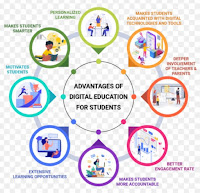Technology Makes Learning Easier
- How technology makes learning easier?
Technology has transformed the way people learn, making education more accessible, engaging, and efficient. In the past, learning was limited to classrooms, textbooks, and traditional teaching methods. Today, digital tools, online resources, and interactive platforms have revolutionized education, allowing students to learn anytime and anywhere. From virtual classrooms and AI-driven tutoring to educational apps and collaborative tools, technology enhances learning experiences and caters to different learning styles. This essay explores how technology makes learning easier by providing access to information, improving engagement, and personalizing education for learners of all ages.
- Technology makes learning easier in several ways:
1. Access to Information –
The internet provides instant access to vast educational resources, including videos, articles, and e-books.
2. Interactive Learning –
Apps, games, and simulations make learning engaging and hands-on.
3. Personalized Education –
AI-driven platforms adapt to students’ learning speeds and styles, offering customized lessons.
4. Remote Learning –
Online classes and virtual classrooms allow learning from anywhere.
5. Collaboration & Communication –
Tools like Zoom, Google Docs, and discussion forums help students and teachers interact easily.
6. Efficient Note-Taking & Organization –
Digital tools like Evernote and OneNote help students organize their studies.
7. Instant Feedback –
Online quizzes and AI tutors provide immediate corrections and suggestions.
8. Enhanced Creativity –
Multimedia tools allow students to create videos, presentations, and digital projects.
Technology removes barriers to education and makes learning more flexible and efficient.
- How Digital Media Makes Learning Easier
Digital media has transformed education by making learning more engaging, accessible, and interactive. Through videos, podcasts, animations, e-books, and social media, students can absorb information in diverse and dynamic ways. Unlike traditional textbooks and lectures, digital media caters to different learning styles, ensuring that students understand and retain knowledge more effectively.
Educational Videos –
Platforms like YouTube, TED-Ed, and Khan Academy offer explainer videos that simplify complex topics using animations and real-life examples.
Infographics & Animations –
Tools like Canva and Piktochart help create visually appealing study materials that summarize key concepts.
e.g.,https://piktochart.com/
Interactive Storytelling –
Websites like Storybird allow students to learn through digital storytelling, enhancing creativity and comprehension.
e.g.,https://storynest.ai/?
E-books & Audiobooks –
Kindle, Audible, and Google Books allow students to access textbooks in digital format.
e.g.,https://www.ebooks.com/en-in/?srsltid=AfmBOorUAzVN4xEr0JyHZ3PesSrkpc1SH_rwV9FSNWI6A0RmRcz_Rln-
Podcasts & Recorded Lectures –
Educational podcasts like “Stuff You Should Know” and university-recorded lectures let students learn while commuting or doing other activities.
Social Media for Learning –
Platforms like Twitter, LinkedIn, and Reddit offer discussion groups and expert insights on academic topics.
As technology continues to evolve, its role in education will only grow, offering new opportunities for students and educators alike. By embracing digital learning tools, we can create a more inclusive, efficient, and enjoyable educational experience for all.
Citesation:
• Chat GPT
•Goggle Chrome
•Wikipedia



Comments
Post a Comment